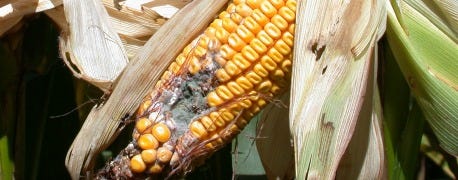
Earlier this year Purdue University entomologists noted the break in corn rootworm resistance found in Minnesota fields a couple years ago, where corn with the same GMO trait for control was grown for several years, hasn’t yet been seen in Indiana.
However, Denny Cobb, agronomist with Beck’s, says the company's seed reps did find instances where western bean cutworm wasn’t controlled as well in 2015 by a different trait than it had been in past years. They have not seen signs of the rootworm resistance issue either, however.

TOUGH CUSTOMER: Western bean cutworm can do tons of damage in susceptible fields. This hybrid did not have any GMO resistance to western bean cutworm. (Photo courtesy of Ben Grimme, Beck’s)
Western bean cutworm (WBC) attacks ears with a vengeance when corn is susceptible: boring several holes into an ear, setting up everything from ear to sprouting, and slamming yields. Resistance through GMOs controlled the problem, Cobb notes. The western bean cutworm problem is more common in certain areas of the state, particularly on sandy soils.
When the hybrid is susceptible and WBC pressure is high, enough destruction can be done in the field to cause damaged grain. The sprouting and molding starts because the insects open the husks by chewing, letting insects, fungi and bacteria invade the ear and the plant.
The damage found in 2015 in fields planted with a trait that had been totally effective wasn’t nearly that severe, Cobb reports. However, there was enough damage to indicate that the western bean cutworms were able to survive in some cases -- at least long enough to do some damage to the ears. The fact that they did any damage at all indicated that they may be overcoming the resistance provided by that trait.

NOT CLEAN ANYMORE: The ear on the left did not have GMO resistance to WBC. The ear on the right, even though it’s from a hybrid with resistance to WBC that worked for several years, showed damage in 2015.
Fortunately, there are other traits on the market that offer a different resistance, Cobb says. The Viptera trait from Syngenta is one that controls western bean cutworm. No issues with insects breaking through resistance have been reported with that trait.
About the Author(s)
You May Also Like




